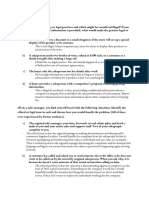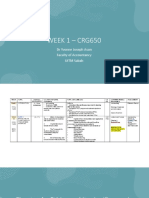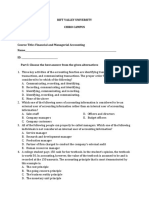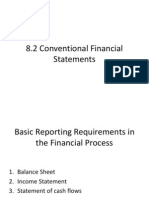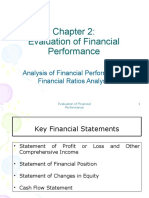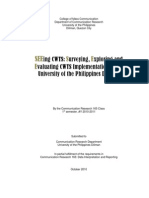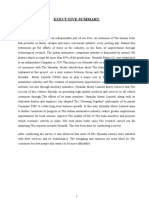Full Report (Pbl1)
Full Report (Pbl1)
Uploaded by
NuHar MisranCopyright:
Available Formats
Full Report (Pbl1)
Full Report (Pbl1)
Uploaded by
NuHar MisranOriginal Description:
Copyright
Available Formats
Share this document
Did you find this document useful?
Is this content inappropriate?
Copyright:
Available Formats
Full Report (Pbl1)
Full Report (Pbl1)
Uploaded by
NuHar MisranCopyright:
Available Formats
ACCOUNTING INFORMATION SYSTEM (AIS630)
ACCOUNTING INFORMATION SYSTEM (AIS630) PROBLEM BASED LEARNING (SESSION 1) REPORT
PREPARED BY: NIK SYAMIN AMIRA BT NIK KAMARUZAMAN AZUREEN BT JULIAN REMMY OCTAVIA MAILEDY NUR FATHIN FARHAIN BT GHAZALI NUR IZZATIE BT JAUSUS MOHD AZMY B JOHARI GROUP : AC220 6J PREPARED FOR : MADAM AIDA MARIA BT ISMAIL 2009676986 2009459662 2009213048 2009627688 2009656892 2009659498
PROBLEM BASED LEARNING (SESSION 1)
Page 1
ACCOUNTING INFORMATION SYSTEM (AIS630)
Contents
ACKNOWLEDGEMENT ................................................................................................................................... 3 QUESTION A .................................................................................................................................................. 4 QUESTION B .................................................................................................................................................. 5 QUESTION C .................................................................................................................................................. 6 QUESTION D .................................................................................................................................................. 7 QUESTION E .................................................................................................................................................. 8 QUESTION F................................................................................................................................................... 9 QUESTION G ................................................................................................................................................ 10 QUESTION H ................................................................................................................................................ 11 QUESTION I ................................................................................................................................................. 11 QUESTION J ................................................................................................................................................. 12 QUESTION K ................................................................................................................................................ 13 QUESTION L ................................................................................................................................................. 14 QUESTION L ................................................................................................................................................. 16 QUESTION M ............................................................................................................................................... 17 CONCLUSION............................................................................................................................................... 18
PROBLEM BASED LEARNING (SESSION 1)
Page 2
ACCOUNTING INFORMATION SYSTEM (AIS630)
ACKNOWLEDGEMENT
I wish to express my sincere gratitude to Madam Aida Maria bt Ismail for providing our group an opportunity to do our problem based learning session 1. This project bears on imprint of many peoples. I sincerely thank to our group members itself for giving such brilliant cooperation and for the fruity ideas along finishing this project. Other than that, our group also want to thank to our classmates for guidance and encouragement in carrying out this project work we also wish to express my gratitude to the staff officers of faculty who rendered their help during the period of our project work. Last but not least I wish to avail ourself of this opportunity, express a sense of gratitude and love to my friends and my beloved parents for their manual support, strength, help and for everything.
PROBLEM BASED LEARNING (SESSION 1)
Page 3
ACCOUNTING INFORMATION SYSTEM (AIS630)
QUESTION A
A) Discuss among your group and choose any products or services for your company. It is advisable to select simple products/services with just a few variants. Create a logo and motto for your company and do not forget to name your company.
The name of our company is Beautique. It is a combination from the word Beautiful and Boutique. Our companys motto is Style with Confidence Our company offers a wide range of beautiful clothing such as dresses, blouses, skirts and others which we get from trusted as well as branded suppliers. Other than that, our company also provide accessories such as handbags, clutches, brooches, and many more.
PROBLEM BASED LEARNING (SESSION 1)
Page 4
ACCOUNTING INFORMATION SYSTEM (AIS630)
QUESTION B
B) Prepare a draft of system request for the proposed ordering system. Think about the benefits of having that system. You may name sales department as the project sponsor but you need to emphasize more on the functionality of the proposed system. State at least one constraint in the system request. Customer can make order through our on-line system Process of making order: 1) Customers are required to register as a member to make the ordering process easier and faster. 2) After they have registered, they can log in to their account and starts to shops. 3) They can put the apparels that they wish to buy in their cart. 4) After they have finished, they can view their cart and see all the apparels that they have put in their cart. The total amount of their order will be shown too. They can still edit the items in their cart. 5) Once they are satisfied, they can confirm the order. Once the order is made, no cancellation is allowed. 6) If the customers are still having hesitation whether to buy or not, they can reserved the items that they want. The reservation will be hold for 2 weeks for regular customer while reservation for new customer is only 3 days. 7) Customers are required to confirm the order of their reserved items within the time frame given. If not, they are deemed to be not interested to buy anymore. 8) After an order is made, an invoice will be sent to the customers e-mail address. The invoice will show the details of customers such as name, address and contact number. Details of the order such as the order code, ordered item, and the total amount to be paid including postage will also be shown in the invoice. 9) Customers are required to make payment within 2 days after they received the invoice. Once they have made payment, they are requested to submit the proof of payment being made. 10) Once the proof of payment is received and confirmed, the order will be process and a notification will be sent to the customer stating that their order is being processed. 11) After the order is being processed and completed, it will be shipped to the customers. Another notification stating that the order is completed will be sent to the customers. 12) Customers who have purchased more than RM200 can request for a cash on delivery (COD) within Shah Alam.
PROBLEM BASED LEARNING (SESSION 1)
Page 5
ACCOUNTING INFORMATION SYSTEM (AIS630)
QUESTION C
C) Who should evaluate system request? Discuss how a system request is evaluated. The system request should be evaluated by: - Key managers - Users - System review committee
A system request is evaluated through: 1) Technical Feasibility It involves determining whether a proposed information system is possible given the current state of technology. 2) Operational Feasibility It covers two aspects which is technical performance and acceptance within the organization. 3) Economic Feasibility It involves determining whether a proposed information system will yield benefits that exceed its costs.
PROBLEM BASED LEARNING (SESSION 1)
Page 6
ACCOUNTING INFORMATION SYSTEM (AIS630)
QUESTION D
D) For each of the concerns listed above, determine whether it is a business problem or a symptom. Discuss what could be the real problem if you find it to be the latter. 1. Customer services were accused of being inefficient for keeping the customers waiting too long on the phone to get information on certain products. One of the key reasons for the delay is customer services needs to flip through the catalogue to find product information. Problem 2. There are complaints that products being shipped to the wrong customer address even though the company is using reliable courier service. Symptom Real problem: Problem originating from shipping department in assigning wrong address to the wrong parcel. 3. Hot selling items sometimes run out of stock and takes time to replenish resulting in loss of sales. Random check with suppliers dismissed any suggestion of insufficient supplies. Symptom Real problem: The real problem is that the purchasing department fails to analyze efficiently the hot selling items stock/flow. 4. It is difficult to retain customers loyalty since sales department could not properly identify their regular customers who deserve certain amount of discounts. Symptom Real problem: Problem is that they do not have proper recognition of customers transactions. 5. Sales person sometimes wrongly calculate the total sales amount as they have to do it manually and in some cases provides wrong quotation to customers. Sales amount understatement will result in loss company while overcharging a customers will result in complaints and lead to bad company reputation. Problem
PROBLEM BASED LEARNING (SESSION 1)
Page 7
ACCOUNTING INFORMATION SYSTEM (AIS630)
QUESTION E
E) Develop the project goals for each of the problem identified.
Problem 1.
Project Goals To make an efficient customer service by developing software that eases the employee to search for the product information. Therefore, customers will not have to wait.
2.
To avoid lack of employee awareness by supervising the employees of shipping department before the parcels are sent. More supervising will increase their awareness on assigning the right address to the right parcel.
3.
Properly analyze the flow of the products by developing website system that can detect which product is the best seller. Thus, setting the order point for the best seller product.
4.
To identify the regular customers by requiring customers to register an account so that the customers transactions are recorded. Therefore, amount of discounts that should be given can be determined by referring to the records.
5.
To increase the usage of technology by developing software that enables the sales person to key in the customers transactions. Thus, the software will automatically lump sum the total sales.
PROBLEM BASED LEARNING (SESSION 1)
Page 8
ACCOUNTING INFORMATION SYSTEM (AIS630)
QUESTION F
F) Compare the project goals with the systems request. Use the project goals to determine which part of the request goes beyond the scope of your project. System Request Customers are required to register as a member to make the ordering process Project Goal Customers are required to register an account so that the customers transactions are recorded. Ordering through online system will record which item is bought. Develop website system that can detect which product customer bought the most. Allign Allign Allign/Not Allign
Conclusion The system request is align with the project goals. The request does not go beyond the scope of our project. The system request fits the needs and requirements of our project goals.
PROBLEM BASED LEARNING (SESSION 1)
Page 9
ACCOUNTING INFORMATION SYSTEM (AIS630)
QUESTION G
G) Draw PERT Chart for the above project
20
80
A,5 B,5 E,5 G,20 H,30 I,15
10
C,15
30
D,15
40
60
70
J,10
90
K,15
100
L,10
110
M,5
120
F,20
Dummy
50
PROBLEM BASED LEARNING (SESSION 1)
Page 10
ACCOUNTING INFORMATION SYSTEM (AIS630)
QUESTION H
H) Identify the projects critical path and its duration. Define what is meant by slack time and give one example from the above project. The Critical Path is the longest necessary path through a network of activities when respecting their interdependencies, which may be identified with the Program Evaluation and Review Technique and the Critical path method. Based on the projects PERT Chart above, the critical path is A-C-D-F-G-H-I-M which takes 120 days to complete the project.
Slack time can be defined as the amount of time a task can be delayed without causing another task to be delayed or impacting the completion date of your project. Depend on the project above, the slack time that the project can be beard is 15 days which occurred between Task E and F. Task G only can be started once Task E and F are completed. Since Task E only take 5 days compared to Task F, therefore Task E can be delayed for maximum 15 days only. Otherwise, it would affect completion date of the project.
QUESTION I
I ) Assuming that you have to delay Task I by 10 days, how would it affect your project completion date? What if the delay is for Task K instead, would it result in the same affect? If Task I in the project is delayed by 10 days, the completion date of the project also would be delay by 10 days because Task I is included in the critical path. If Task K is delayed by 10 days, it would not affect the completion date of the project. It is because Task K is not included in the critical path of the project. The maximum days the Task K can be delayed is 15 days which mean slack time of the project. If the task delayed for more than 15 days, it would certainly affect the completion date of the project.
PROBLEM BASED LEARNING (SESSION 1)
Page 11
ACCOUNTING INFORMATION SYSTEM (AIS630)
QUESTION J
J) What are the advantages of using PERT Chart over Gantt chart for project scheduling.
The Gantt chart focuses on task sequence. Each task is represented as a horizontal bar showing the length of time it will take to complete. Whereas PERT chart is to help manage very complex projects. Each chart begins with an initiation node that branches out into networks of tasks. Element Time and Relationships Gantt Chart emphasize the time it takes to complete tasks PERT Chart emphasize relationships between tasks.
Linear Vs. Interconnecting
Linear. linear. Any relationships between tasks on a Gantt chart are depicted with arrows
have several parallel or interconnecting networks of tasks
Straightforward Vs. Complex
work well for more straightforward projects that most likely will not require mid-stream changes.
designed for only parts of projects and end at the major review points
Dependency
Not stated any dependency of tasks before starting the next task.
Explicitly defines and makes visible dependencies (precedence relationships) between the tasks.
Critical Path Identification
Not stated any critical path of the project
Stated and clearly define the ciritical of the project, as well as slack time of the project.
PROBLEM BASED LEARNING (SESSION 1)
Page 12
ACCOUNTING INFORMATION SYSTEM (AIS630)
QUESTION K
K) Suggest how you could improve the above questionnaire. Redraft the questionnaire. I. Instruction at the beginning of the questionnaire. We must clearly state what the respondent should do in answering the questionnaire. II. Briefly simple introduction about what purpose of the questionnaire is held. This is to make sure the respondent understands the questionnaire. III. Protect privacy of the respondent. Usually good questionnaire should not come with personal details such as name or identity card number and also contact no. This is to avoid any bias. IV. Avoid spelling error and grammar. To avoid the respondents to misunderstanding the questions in the questionnaire. V. Sequence lead questions. Means that the questions must be accordingly sequence which is connecting between each question.
PROBLEM BASED LEARNING (SESSION 1)
Page 13
ACCOUNTING INFORMATION SYSTEM (AIS630)
QUESTIONNAIRE FOR SALES DEPARTMENT STAFF INTROUCTION : THIS SURVEY IS CONDUCTTED TO DISCOVER ANY PROBLEM ARISED IN THE SALES DEPARTMENT AMONG SALES DEPARTMENT OFFICERS
AGE :
20-30
31-40
41-50
SEX :
MALE FEMALE
INSTRUCTION : TICK YOUR ANSWER. ONLY ONE ANSWER PER QUESTION. STAFF NEED TO ANSWER ALL QUESTIONS.
1. How long you have served in this department ? Less than 1 year 1 to 5 years more than 5 years
QUESTION L
2. How many times did you encounter problem with customer orders in the last 6 months? Always Seldom Never 3. Do you know other people who face similar problems?
YES NO
i) Questionnaire think that our currentopen-ended questions so as not to constrain the 4. Do you should include only ordering system is problematic? respondents. Do you agree with this statement? What are the advantages and the disadvantages YES of having open-ended questionnaire? NO No. I do not agree since questionnaire should include both close-ended and open-ended questionnaire. Advantages and disadvantages of open-ended questionnaire are:
PROBLEM BASED LEARNING (SESSION 1) Page 14
ACCOUNTING INFORMATION SYSTEM (AIS630) 5. Do you have encountered any biggest problems so far? If Yes, stated briefly. NO YES. State. __________________________ 6. Suggest improvement(s) to our ordering system
__________________________________ __________________________________ __________________________________ __________________________________
7. other comments
THANKS FOR FILLING THIS QUESTIONNAIRE. YOUR COOPERATION IS MUCH APPRECIATED.
PROBLEM BASED LEARNING (SESSION 1)
Page 15
ACCOUNTING INFORMATION SYSTEM (AIS630)
QUESTION L
L) Questionnaire should include only open-ended questions so as not to constrain the respondents. Do you agree with this statement? What are the advantages and the disadvantages of having open-ended questionnaire? No. I do not agree since questionnaire should include both close-ended and open-ended questionnaire. Advantages and disadvantages of open-ended questionnaire are: Advantages: Open-ended questions allow respondents to include more information, including feelings, attitudes and understanding of the subject. This allows researchers to better access the respondents' true feelings on an issue. . Open-ended questions cut down on two types of response error; respondents are not likely to forget the answers they have to choose from if they are given the chance to respond freely, and open-ended questions simply do not allow respondents to disregard reading the questions and just "fill in" the survey with all the same answers (such as filling in the "no" box on every question). Disadvantages: If open-ended questions are analyzed quantitatively, the qualitative information is reduced to coding and answers tend to lose some of their initial meaning. Because open-ended questions allow respondents to use their own words, it is difficult to compare the meanings of the responses. The response rate is lower with surveys that use open-ended question than with those that use closed-ended questions.
PROBLEM BASED LEARNING (SESSION 1)
Page 16
ACCOUNTING INFORMATION SYSTEM (AIS630)
QUESTION M
M) Suggest other techniques that can be used to get information from the sales department. I. Interviews. The sales department can get information through interview. They can interview their target respondent which is their own employees by setting the time of interview and also prepare the question type and structure whether structure or unstructured.
II.
Review of documents. Written of documents include manuals, procedures, forms, reports etc can be valuable information about an organization and its operations. This can reveal to sales department the existing system should work and the information required to answer all the questions needed in the questionnaire.
III.
Observation. This allow sales department to gain information that they cannot get by any other information gathering techniques. By this, sales department can answer the question that need to be fill out by making an observation throughout its employees.
PROBLEM BASED LEARNING (SESSION 1)
Page 17
ACCOUNTING INFORMATION SYSTEM (AIS630)
CONCLUSION
The primary goal of this report is to create an innovative and creative graduates for creating our own business database. To the end, this problem based learning really improve our creative level and become more innovative in thinking what to be improved onwards to be in line with our technology level. This project also has increased our confident level to start up a new business and try a new thing in making ourselves more success in the future. This project also has exposed us how to create a business database so that the knowledge can be implemenet and practice when we enter real work life.
PROBLEM BASED LEARNING (SESSION 1)
Page 18
You might also like
- Assignment 1 - Visual Analysis of A Data Set Using Tableau0% (3)Assignment 1 - Visual Analysis of A Data Set Using Tableau5 pages
- AACT 2173 FM Lesson 4 Tutorial (Additional)100% (1)AACT 2173 FM Lesson 4 Tutorial (Additional)11 pages
- Suggested Solution Far 660 Final Exam JUNE 2019No ratings yetSuggested Solution Far 660 Final Exam JUNE 20196 pages
- Chapter 1 ETHICS AND ITS SIGNIFICANCE IN THE BUSINESS DISCIPLINENo ratings yetChapter 1 ETHICS AND ITS SIGNIFICANCE IN THE BUSINESS DISCIPLINE16 pages
- Covalent: Term Loan For Expansion and Modernization: Submitted By: Group 10No ratings yetCovalent: Term Loan For Expansion and Modernization: Submitted By: Group 1012 pages
- Corporate Governance - Lehman Brothers - Group 3No ratings yetCorporate Governance - Lehman Brothers - Group 321 pages
- Tutorial 1 - Introduction To Enterprise Systems (For Students)No ratings yetTutorial 1 - Introduction To Enterprise Systems (For Students)3 pages
- Business Intelligence and Inventory A Case Study of Dicks Sporting Goods 29-06-2007No ratings yetBusiness Intelligence and Inventory A Case Study of Dicks Sporting Goods 29-06-200717 pages
- Read The Question Paper Carefully and Answer The Questions According To Their Statements100% (1)Read The Question Paper Carefully and Answer The Questions According To Their Statements6 pages
- Airtran Airways - 2009: A. Case AbstractNo ratings yetAirtran Airways - 2009: A. Case Abstract13 pages
- CH 6 - Capital Structure - Basic ConceptsNo ratings yetCH 6 - Capital Structure - Basic Concepts29 pages
- A162 Answer Tutorial 1 and Answer Siti Norliza0% (2)A162 Answer Tutorial 1 and Answer Siti Norliza13 pages
- TQM Presentation - Management Accounting & Performance AnalysisNo ratings yetTQM Presentation - Management Accounting & Performance Analysis58 pages
- Chapter 1 Lecture Note Strategy, Business Models, and Competitive AdvantageNo ratings yetChapter 1 Lecture Note Strategy, Business Models, and Competitive Advantage7 pages
- Maf253 Topic 2 Analysis of Financial Performance - Financial Ratio AnalysisNo ratings yetMaf253 Topic 2 Analysis of Financial Performance - Financial Ratio Analysis49 pages
- Individual Assignment Opm560 Case Study Nor Syazwani 2022905573No ratings yetIndividual Assignment Opm560 Case Study Nor Syazwani 20229055736 pages
- Complete Download (Ebook PDF) Entrepreneurship: Theory, Process, Practice 11th Edition PDF All Chapters100% (6)Complete Download (Ebook PDF) Entrepreneurship: Theory, Process, Practice 11th Edition PDF All Chapters41 pages
- 1) The Name of Our Company: - SH Door GiftNo ratings yet1) The Name of Our Company: - SH Door Gift8 pages
- Food Quality and Preference: Christina Hartmann, Jing Shi, Alice Giusto, Michael SiegristNo ratings yetFood Quality and Preference: Christina Hartmann, Jing Shi, Alice Giusto, Michael Siegrist9 pages
- EDID 6504 - Group Project - We CARE Citizen Development ProgrammeNo ratings yetEDID 6504 - Group Project - We CARE Citizen Development Programme34 pages
- The Life of The Sikad Sikad Driver Impre-1No ratings yetThe Life of The Sikad Sikad Driver Impre-115 pages
- Teachers Evaluation and Statistical Analysis Used by ABM Students in Assessing Their Educational GoalsNo ratings yetTeachers Evaluation and Statistical Analysis Used by ABM Students in Assessing Their Educational Goals34 pages
- Topline & Methodology: ABC News/Ipsos PollNo ratings yetTopline & Methodology: ABC News/Ipsos Poll5 pages
- Final Paper Draft LALS 100A - Chance CayetanoNo ratings yetFinal Paper Draft LALS 100A - Chance Cayetano17 pages
- LESSON 2 FORECASTING in Operations ManagementNo ratings yetLESSON 2 FORECASTING in Operations Management45 pages
- Quantitative Research Final EffectsOfPeerPressure100% (1)Quantitative Research Final EffectsOfPeerPressure55 pages
- (2020) - Mushiri, Development of An Asset Criticality Assessment ToolNo ratings yet(2020) - Mushiri, Development of An Asset Criticality Assessment Tool12 pages
- Residents Attitudes Toward Support For Island SusNo ratings yetResidents Attitudes Toward Support For Island Sus16 pages
- Assignment 1 - Visual Analysis of A Data Set Using TableauAssignment 1 - Visual Analysis of A Data Set Using Tableau
- Chapter 1 ETHICS AND ITS SIGNIFICANCE IN THE BUSINESS DISCIPLINEChapter 1 ETHICS AND ITS SIGNIFICANCE IN THE BUSINESS DISCIPLINE
- Covalent: Term Loan For Expansion and Modernization: Submitted By: Group 10Covalent: Term Loan For Expansion and Modernization: Submitted By: Group 10
- Tutorial 1 - Introduction To Enterprise Systems (For Students)Tutorial 1 - Introduction To Enterprise Systems (For Students)
- Business Intelligence and Inventory A Case Study of Dicks Sporting Goods 29-06-2007Business Intelligence and Inventory A Case Study of Dicks Sporting Goods 29-06-2007
- Read The Question Paper Carefully and Answer The Questions According To Their StatementsRead The Question Paper Carefully and Answer The Questions According To Their Statements
- TQM Presentation - Management Accounting & Performance AnalysisTQM Presentation - Management Accounting & Performance Analysis
- Chapter 1 Lecture Note Strategy, Business Models, and Competitive AdvantageChapter 1 Lecture Note Strategy, Business Models, and Competitive Advantage
- Maf253 Topic 2 Analysis of Financial Performance - Financial Ratio AnalysisMaf253 Topic 2 Analysis of Financial Performance - Financial Ratio Analysis
- Individual Assignment Opm560 Case Study Nor Syazwani 2022905573Individual Assignment Opm560 Case Study Nor Syazwani 2022905573
- Complete Download (Ebook PDF) Entrepreneurship: Theory, Process, Practice 11th Edition PDF All ChaptersComplete Download (Ebook PDF) Entrepreneurship: Theory, Process, Practice 11th Edition PDF All Chapters
- Food Quality and Preference: Christina Hartmann, Jing Shi, Alice Giusto, Michael SiegristFood Quality and Preference: Christina Hartmann, Jing Shi, Alice Giusto, Michael Siegrist
- EDID 6504 - Group Project - We CARE Citizen Development ProgrammeEDID 6504 - Group Project - We CARE Citizen Development Programme
- Teachers Evaluation and Statistical Analysis Used by ABM Students in Assessing Their Educational GoalsTeachers Evaluation and Statistical Analysis Used by ABM Students in Assessing Their Educational Goals
- (2020) - Mushiri, Development of An Asset Criticality Assessment Tool(2020) - Mushiri, Development of An Asset Criticality Assessment Tool


